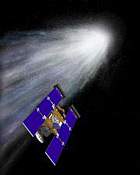 Remember the famous Buran (Russian for "Snowstorm") shuttle designed by the USSR to compete with NASA's shuttle? In fact, it looked almost identical from a distance. What ever happened to this experimental craft? When looking up some of the details I found that the Buran came off the production line in 1984, test launched in 1988, and was moth-balled in 1993. Last word is that the manufacturing plant now makes diapers and a Buran 1:1 scale version became a restaurant in Gorky Park. The Russians have a lot to be proud of throughout the space race, but this was not its high moment. Click here for more on the current Russian programs, including the OBSTANOVKA space weather project related to the International Space Station.
Remember the famous Buran (Russian for "Snowstorm") shuttle designed by the USSR to compete with NASA's shuttle? In fact, it looked almost identical from a distance. What ever happened to this experimental craft? When looking up some of the details I found that the Buran came off the production line in 1984, test launched in 1988, and was moth-balled in 1993. Last word is that the manufacturing plant now makes diapers and a Buran 1:1 scale version became a restaurant in Gorky Park. The Russians have a lot to be proud of throughout the space race, but this was not its high moment. Click here for more on the current Russian programs, including the OBSTANOVKA space weather project related to the International Space Station.Wednesday, January 25
The Little "Snowstorm" That Couldn't
 Remember the famous Buran (Russian for "Snowstorm") shuttle designed by the USSR to compete with NASA's shuttle? In fact, it looked almost identical from a distance. What ever happened to this experimental craft? When looking up some of the details I found that the Buran came off the production line in 1984, test launched in 1988, and was moth-balled in 1993. Last word is that the manufacturing plant now makes diapers and a Buran 1:1 scale version became a restaurant in Gorky Park. The Russians have a lot to be proud of throughout the space race, but this was not its high moment. Click here for more on the current Russian programs, including the OBSTANOVKA space weather project related to the International Space Station.
Remember the famous Buran (Russian for "Snowstorm") shuttle designed by the USSR to compete with NASA's shuttle? In fact, it looked almost identical from a distance. What ever happened to this experimental craft? When looking up some of the details I found that the Buran came off the production line in 1984, test launched in 1988, and was moth-balled in 1993. Last word is that the manufacturing plant now makes diapers and a Buran 1:1 scale version became a restaurant in Gorky Park. The Russians have a lot to be proud of throughout the space race, but this was not its high moment. Click here for more on the current Russian programs, including the OBSTANOVKA space weather project related to the International Space Station.Tuesday, January 24
What is the Kuiper Belt?
The Kuiper Belt is the region beyond Neptune containing much of the same material used to form our solar system. Pluto is one of the larger bodies from this area, but it is also the home of the comets that frequent the inner solar system. The Kuiper Belt was proposed by Dutch astronomer Jan Oort back in 1950. However it is astronomer Gerard Kuiper who has his name associated with this belt. His predictions concerning comets from this region were not fully proven until 1992. So all of this is still recent science. And what about Pluto? It is the monster of ice planets? Actually, no. In fact, Xena holds this title. Read here for more.
Sunday, January 22
2.9 Billion Miles - For Dust?
 NASA's Stardust space capsule is now safely back on Earth after quite a journey. Scientists are now studying the payload (about one teaspoon of dust) that successfully landed in the Utah desert. We will now learn much more about the comets that circle our solar system and thereby more about the early foundations of our own planet some 4.5 billion years ago. Visit NASA's Jet Propulsion Laboratory for more on the progress of the research.
NASA's Stardust space capsule is now safely back on Earth after quite a journey. Scientists are now studying the payload (about one teaspoon of dust) that successfully landed in the Utah desert. We will now learn much more about the comets that circle our solar system and thereby more about the early foundations of our own planet some 4.5 billion years ago. Visit NASA's Jet Propulsion Laboratory for more on the progress of the research.
Friday, January 20
Viewing New Horizons
 We are off to a great start as we head towards the last planet in the solar system! The 3 billion mile trip to Pluto began yesterday and now we have a show that will last at least 9.5 years. NASA's New Horizons spacecraft broke away from Earth's and will someday visit Pluto and then break away from the inner solar system and inspect the Kuiper Belt - a cold and ice filled region from which planetoids periodically appear. You can monitor this little craft by visiting the Johns Hopkins University site.
We are off to a great start as we head towards the last planet in the solar system! The 3 billion mile trip to Pluto began yesterday and now we have a show that will last at least 9.5 years. NASA's New Horizons spacecraft broke away from Earth's and will someday visit Pluto and then break away from the inner solar system and inspect the Kuiper Belt - a cold and ice filled region from which planetoids periodically appear. You can monitor this little craft by visiting the Johns Hopkins University site.Note: This if the first entry of Mars or Bust...a site designed to keep you wondering about this amazing world. Be it Pluto, Mars, the Milky Way or the Big Bang itself, the investigation is just beginning.
Labels:
Johns Hopkins University,
Kuiper Belt,
NASA,
New Horizons,
Pluto
Subscribe to:
Comments (Atom)
